This article needs additional citations for verification .(January 2013) |
In humans, the crotch is the bottom of the pelvis (the region of the body where the legs join the torso) and is often considered to include the groin and genitals.
This article needs additional citations for verification .(January 2013) |
In humans, the crotch is the bottom of the pelvis (the region of the body where the legs join the torso) and is often considered to include the groin and genitals.
Crotch is derived from crutch; it was first used in 1539 to refer to a forked stick used as a farm implement. [1] This region of the body is also described with other terms such as groin or the lower ventral area. [2]
In clothing, the crotch is the area of trousers, shorts, leggings etc. where the legs join. The bottom of the crotch is an end of the inseam. The crotch-region on smaller garments such as underwear are sometimes referred to as the pouch. [3] Loosely-fitted or bagginess in the crotch-region is sometimes associated with a lax, casual and easy-going approach to attires or garbs. [4]
Clothing that is tight-fitting in the crotch produces an effect that is sometimes referred to by informal terms such as a man-bulge [5] or moose-knuckle [6] on men, and a camel toe on women, especially if the woman's labia majora are conspicuous. [7] Prolonged constrictive pressure of the crotch on the male genitals may increase the likelihood of detumescing. [8]
The semantic field of the term crotch is sometimes expanded to include objects which have a similar shape to the anatomical human crotch. [9] This may include botanical structures such as the area where tree branches are joined together [10] or mechanical structures which fork or branch or where ramification takes place. [11] The term had also been expanded to include the joining together of asymmetrical surfaces in cue sports equipment or the corners of flat surfaces usually made of quarried slate. [12]
| | This section needs expansion. You can help by adding to it. (January 2013) |
The human crotch has been depicted in artwork. In Paleolithic art, forms called tectiforms or quadrilaterals have sometimes been interpreted to be "quick visual guides, reminders to the imagination" of the female crotch, and typically do not represent the crotch hairs. [13]
Classical marble statues depict females without pubic hair; in contrast, statues of males "show curly pubic hair". [14]
For much of the history of European art – "until the late seventeenth century" – references to the female crotch were approached from above: "Art usually expressed the sense of the vulva as a point at the bottom of the belly rather than as the meeting place at the top of the thighs." [15]
Art therapists have noted "a triangular or vaginal shaped area in drawings by rape/sexual abuse victims". [16]
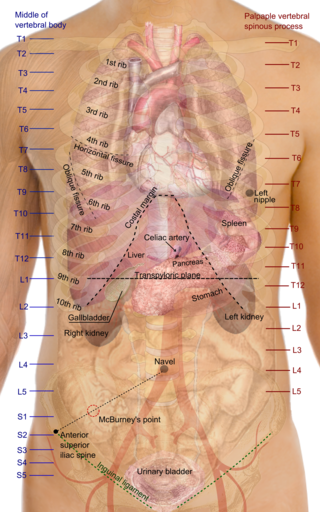
Surface anatomy is the study of the external features of the body of an animal. In birds, this is termed topography. Surface anatomy deals with anatomical features that can be studied by sight, without dissection. As such, it is a branch of gross anatomy, along with endoscopic and radiological anatomy. Surface anatomy is a descriptive science. In particular, in the case of human surface anatomy, these are the form and proportions of the human body and the surface landmarks which correspond to deeper structures hidden from view, both in static pose and in motion.

The crab louse or pubic louse is an insect that is an obligate ectoparasite of humans, feeding exclusively on blood. The crab louse usually is found in the person's pubic hair. Although the louse cannot jump, it can also live in other areas of the body that are covered with coarse hair, such as the perianal area, the entire body, and the eyelashes.

Pubic hair is terminal body hair that is found in the genital area of adolescent and adult humans. The hair is located on and around the sex organs and sometimes at the top of the inside of the thighs. In the pubic region around the pubis bone and the mons pubis that covers it, it is known as a pubic patch. Pubic hair is also found on the scrotum and base of the penile shaft in the male and on the vulva in the female.
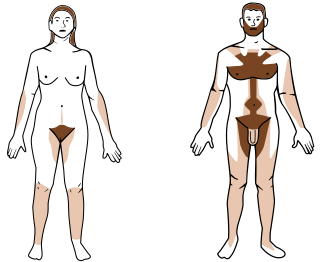
Hair removal, also known as epilation or depilation, is the deliberate removal of body hair or head hair.
An intimate part, personal part or private part is a place on the human body which is customarily kept covered by clothing in public venues and conventional settings, as a matter of fashion and cultural norms. In several cultures, revealing these parts is seen as a religious offence.

In human anatomy, and in mammals in general, the mons pubis or pubic mound is a rounded mass of fatty tissue found over the pubic symphysis of the pubic bones.

An erogenous zone is an area of the human body that has heightened sensitivity, the stimulation of which may generate a sexual response, such as relaxation, sexual fantasies, sexual arousal and orgasm.
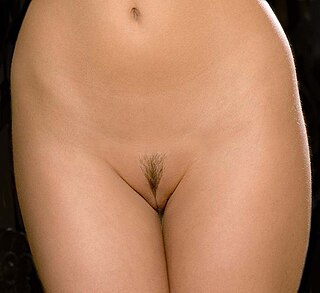
Bikini waxing is the removal of pubic hair using a special wax, which can be hot or cold, that adheres to hairs and pulls them out when the wax is removed quickly from the skin, usually with a cloth strip. While the practice is mainly associated with women, male waxing has become a more common practice to remove men's pubic hair.

Genital tattooing is the practice of placing permanent marks under the skin of the genitals in the form of tattoos.

The axilla is the area on the human body directly under the shoulder joint. It includes the axillary space, an anatomical space within the shoulder girdle between the arm and the thoracic cage, bounded superiorly by the imaginary plane between the superior borders of the first rib, clavicle and scapula, medially by the serratus anterior muscle and thoracolumbar fascia, anteriorly by the pectoral muscles and posteriorly by the subscapularis, teres major and latissimus dorsi muscle.

In human anatomy, the groin also known as the inguinal region or iliac region, is the junctional area between the torso and the thigh. The groin is at the front of the body on either side of the pubic tubercle, where the lower part of the abdominal wall meets the thigh. A fold or crease is formed at this junction known as the inguinal groove, or crease. This is also the area of the medial compartment of the thigh that contains attachments of the adductor muscles of the hip or the groin muscles. The groin is the common site for a hernia.

The labia are the major externally visible portions of the vulva. In humans and other primates, there are two pairs of labia: the labia majora are large and thick folds of skin that cover the vulva's other parts while the labia minora are the inner folds of skin between the outer labia that surround and protect the opening. Inside the vestibule are the openings of the vagina and the urethra. Upward from the labia minora is the clitoral hood that protects the clitoral glans.
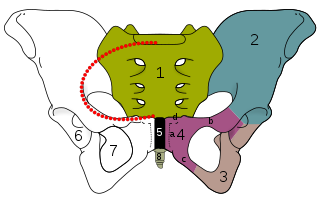
Osteitis pubis is a noninfectious inflammation of the pubis symphysis, causing varying degrees of lower abdominal and pelvic pain. Osteitis pubis was first described in patients who had undergone suprapubic surgery, and it remains a well-known complication of invasive procedures about the pelvis. It may also occur as an inflammatory process in athletes. The incidence and cause of osteitis pubis as an inflammatory process versus an infectious process continues to fuel debate among physicians when confronted by a patient who presents complaining of abdominal pain or pelvic pain and overlapping symptoms. It was first described in 1924.
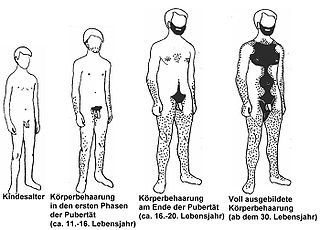
Body hair, or androgenic hair, is terminal hair that develops on the human body during and after puberty. It is different from head hair and also from less visible vellus hair, which is much finer and lighter in colour. Growth of androgenic hair is related to the level of androgens and the density of androgen receptors in the dermal papillae. Both must reach a threshold for the proliferation of hair follicle cells.
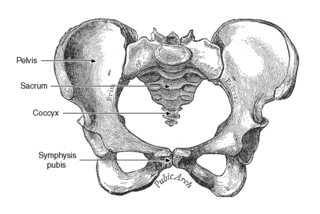
Symphysis pubis dysfunction (SPD), commonly known as pubic symphysis dysfunction or lightning crotch, is a condition that causes excessive movement of the pubic symphysis, either anterior or lateral, as well as associated pain, possibly because of a misalignment of the pelvis. Most commonly associated with pregnancy and childbirth, it is diagnosed in approximately 1 in 300 pregnancies, although some estimates of incidence are as high as 1 in 50.
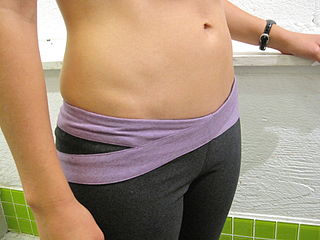
Tucking is a technique whereby an individual hides the crotch bulge of their penis and testicles so that they are not conspicuous through clothing.
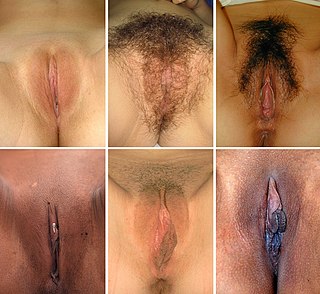
In mammals, the vulva consists of the external female genitalia. The human vulva includes the mons pubis, labia majora, labia minora, clitoris, vestibular bulbs, vulval vestibule, urinary meatus, the vaginal opening, hymen, and Bartholin's and Skene's vestibular glands. The urinary meatus is also included as it opens into the vulval vestibule. Other features of the vulva include the pudendal cleft, sebaceous glands, the urogenital triangle, and pubic hair. The vulva includes the entrance to the vagina, which leads to the uterus, and provides a double layer of protection for this by the folds of the outer and inner labia. Pelvic floor muscles support the structures of the vulva. Other muscles of the urogenital triangle also give support.

Pediculosis pubis is an infestation by the pubic louse, Pthirus pubis, a wingless insect which feeds on blood and lays its eggs (nits) on mainly pubic hair. Less commonly, hair near the anus, armpit, beard, eyebrows, moustache, and eyelashes may be involved. It is usually acquired during sex, but can be spread via bedding, clothing and towels, and is more common in crowded conditions where there is close contact between people.
Of the many characteristics of humans, nakedness and clothing are highly related. The loss of body hair distinguishes humans from other primates. The current evidence indicates that anatomically modern humans were naked in prehistory for at least 90,000 years before the invention of clothing. Today, isolated Indigenous peoples in tropical climates continue to be without clothing in many everyday activities.
It took Weiner a full 20 days to realize he had to resign after a photo of "his man bulge in boxer briefs" hit Twitter on May 27, 2011.